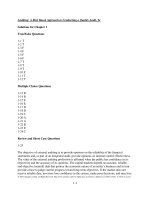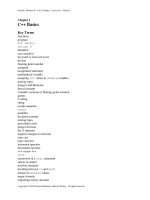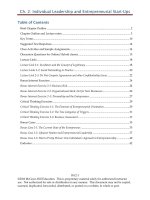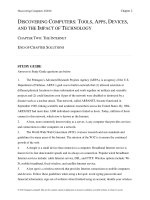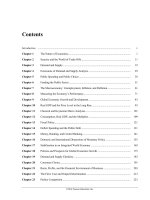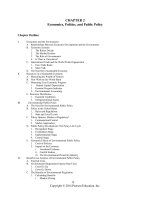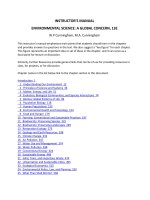Test bank and solution manual of electronics commerce11e (1)
Bạn đang xem bản rút gọn của tài liệu. Xem và tải ngay bản đầy đủ của tài liệu tại đây (310.5 KB, 9 trang )
Electronic Commerce, 11th Edition
Solutions 2-1
Electronic Commerce, 11th Edition
9781285425436
Chapter 2 Solutions
Review Questions
1. What is the difference between an internet (small “i”) and the Internet
(capital “I”)?
Answer: An internet (small “i”) is a group of computer networks that have been
interconnected. In fact, “internet” is short for “interconnected network.” One
particular internet, which uses a specific set of rules and connects networks all over
the world to each other, is called the Internet (capital “I”). Networks of computers and
the Internet that connects them to each other form the basic technological structure
that underlies virtually all electronic commerce.
2. In its early years, the Internet was a military project that became a science
project with funding from the National Science Foundation. In one or two
paragraphs, describe its transition to an environment that allowed and
supported commercial activity.
Answer: In the early 1960s, the U.S. Department of Defense began examining ways to
connect computers to each other and to weapons installations distributed all over the
world. Employing many of the best communications technology researchers, the
Defense Department funded research at leading universities and institutes. The goal
of this research was to design a worldwide network that could remain operational,
even if parts of the network were destroyed by enemy military action or sabotage. In
1969, Defense Department researchers in the Advanced Research Projects Agency
(ARPA) used this direct connection network model to connect four computers—one
each at the University of California at Los Angeles, SRI International, the University
of California at Santa Barbara, and the University of Utah—into a network called the
ARPANET. The ARPANET was the earliest of the networks that eventually
combined to become what we now call the Internet.
E-mail was born in 1972 when Ray Tomlinson, a researcher who used the network,
wrote a program that could send and receive messages over the network. This new
method of communicating became widely used very quickly. As personal computers
became more powerful, affordable, and available during the 1980s, companies
increasingly used them to construct their own internal networks. Although these
networks included e-mail software that employees could use to send messages to each
other, businesses wanted their employees to be able to communicate with people
outside their corporate networks.
Electronic Commerce, 11th Edition
Solutions 2-2
In 1989, the NSF permitted two commercial e-mail services (MCI Mail and
CompuServe) to establish limited connections to the Internet for the sole purpose of
exchanging e-mail transmissions with users of the Internet. These connections
allowed commercial enterprises to send e-mail directly to Internet addresses, and
allowed members of the research and education communities on the Internet to send
e-mail directly to MCI Mail and CompuServe addresses.
3. In one or two paragraphs, explain what is meant by the term “Internet of
Things.”
Answer: The most common perception of the Internet is that it connects computers to
one another and, by doing so, connects the users of those computers to each other. In
recent years, devices other than computers have been connected to the Internet, such
as mobile phones and tablet devices. Once again, the connection of these devices to
the Internet serves to connect the users of those devices to each other. However, the
connection of devices to the Internet that are not used by persons is increasing
rapidly. These devices—such as switches, optical scanners, sensors that detect
changes in temperature, light, moisture, or the existence of vibration or movement—
can be connected to the Internet and used by computers to manage automatically
environmental conditions (such as heating and cooling or lighting levels) or security
procedures. These interconnected devices can be located in houses, offices, factories,
autos, appliances, and so on.
Computers can also be connected to each other using the Internet to conduct business
transactions without human intervention. The subset of the Internet that includes these
computers and sensors connected to each other for communication and automatic
transaction processing is often called the Internet of Things.
4. In a paragraph, explain why packet-switching is better than circuit-switching
for the Internet.
Answer: Although circuit switching works well for telephone calls, it does not work
as well for sending data across a large WAN or an interconnected network like the
Internet. The Internet was designed to be resistant to failure. In a circuit-switched
network, a failure in any one of the connected circuits causes the connection to be
interrupted and data to be lost. Instead, the Internet uses packet switching to move
data between two points.
5. Briefly describe the functions performed by routers in an interconnected
network.
As an individual packet travels from one network to another, the computers
through which the packet travels determine the most efficient route for getting the
packet to its destination. The most efficient route changes from second to second,
depending on how much traffic each computer on the Internet is handling at each
moment.
Electronic Commerce, 11th Edition
Solutions 2-3
The computers that decide how best to forward each packet are called routing
computers, router computers, routers, gateway computers (because they act as the
gateway from a LAN or WAN to the Internet), border routers, or edge routers.
6. In about 100 words, explain the differences between a closed (or proprietary)
architecture and an open architecture. In your answer, be sure to explain
which is used for the Internet and why it is used.
Answer: The first packet-switched network, the ARPANET, connected only a few
universities and research centers. Following its inception in 1969, this experimental
network grew during the next few years and began using the Network Control
Protocol (NCP). In the early days of computing, each computer manufacturer created
its own protocol, so computers made by different manufacturers could not be
connected to each other. This practice was called proprietary architecture or closed
architecture. NCP was designed so it could be used by any computer manufacturer
and was made available to any company that wanted it. This open architecture
philosophy that was developed for the evolving ARPANET, included the use of a
common protocol for all computers connected to the Internet and four key rules for
message handling:
Independent networks should not require any internal changes to be connected
to the network.
Packets that do not arrive at their destinations must be retransmitted from their
source network.
Router computers act as receive-and-forward devices; they do not retain
information about the packets that they handle.
No global control exists over the network.
7. Briefly describe the main concerns a company might have if it is still using
the Internet Protocol version 4 (IPv4).
Answer: The worldwide growth in the number of mobile devices and the Internet of
Things has consumed existing IPv4 addresses much faster than anyone had predicted
and current estimates are that new IPv4 addresses will no longer be available as soon
as 2015.
8. In one or two paragraphs, describe the advantages and disadvantages of
IMAP when compared to POP.
Answer: The Interactive Mail Access Protocol (IMAP) performs the same basic
functions as POP, but includes additional features. For example, IMAP can instruct
the e-mail server to send only selected e-mail messages to the client instead of all
messages. IMAP also allows the user to view only the header and the e-mail sender’s
name before deciding to download the entire message, which avoids the POP
requirement that users download e-mail messages to their computers before they can
search, read, forward, delete, or reply to those messages.
Electronic Commerce, 11th Edition
Solutions 2-4
IMAP lets users create and manipulate e-mail folders (also called mailboxes) and
individual e-mail messages while the messages are still on the e-mail server; that is,
the user does not need to download e-mail before working with it.
IMAP lets users manipulate and store their e-mail on the e-mail server and access it
from any computer, which is important to people who access their email from
different computers at different times. The main drawback to IMAP is that e-mail
messages are stored on the server and, over time, can exceed the user’s space
allowance on the server. In general, server computers use faster (and thus, more
expensive) disk drives than desktop computers. Therefore, it is more expensive to
provide disk storage space for large quantities of e-mail on a server computer than to
provide that same disk space on users’ desktop computers.
9. In two paragraphs, outline how the ideas of Vannevar Bush and Ted Nelson
became key elements of the World Wide Web.
Answer: In 1945, Vannevar Bush, who was director of the U.S. Office of Scientific
Research and Development, wrote an article in The Atlantic Monthly about ways that
scientists could apply the skills they learned during World War II to peacetime
activities. Bush speculated that engineers would eventually build a machine that he
called the Memex, a memory extension device that would store all of a person’s
books, records, letters, and research results on microfilm. Bush’s Memex would
include mechanical aids such as microfilm readers and indexes that would help users
quickly and flexibly consult their collected knowledge.
In the 1960s, Ted Nelson described a similar system in which text on one page links
to text on other pages. Nelson called his page-linking system hypertext. Douglas
Engelbart, who also invented the computer mouse, created the first experimental
hypertext system on one of the large computers of the 1960s. In 1987, Nelson
published Literary Machines, a book in which he outlined project Xanadu, a global
system for online hypertext publishing and commerce.
In 1989, Tim Berners-Lee was trying to improve the laboratory research document
handling procedures for his employer, CERN: European Laboratory for Particle
Physics. Berners-Lee proposed a hypertext development project intended to provide
this data-sharing functionality. Over the next two years, Berners-Lee developed the
code for a hypertext server program and made it available on the Internet.
10. In about 100 words, describe the function of the Internet Corporation for
Assigned Names and Numbers. Include a discussion of the differences
between gTLDs and sTLDs in your answer.
Answer: Since 1998, the Internet Corporation for Assigned Names and Numbers
(ICANN) has had the responsibility of managing domain names and coordinating
them with the IP address registrars. ICANN is also responsible for setting standards
for the router computers that make up the Internet.
Electronic Commerce, 11th Edition
Solutions 2-5
Since taking over these responsibilities, ICANN has added a number of new TLDs.
Some of these are generic top-level domains (gTLDs), which are available to
specified categories of users. Note that ICANN is itself responsible for the
maintenance of gTLDs. Other new domains are sponsored top-level domains
(sTLDs), which are TLDs for which an organization other than ICANN is
responsible.
11. The Web uses a client/server architecture. In about 100 words, describe the
client and server elements of this architecture, including specific examples of
software and hardware that are used to form the Web.
Answer: The Web is software that runs on computers that are connected to each other
through the Internet. Web client computers run software called Web client software
or Web browser software. Examples of popular Web browser software include
Google Chrome, Microsoft Internet Explorer, and Mozilla Firefox.
Web browser software sends requests for Web page files to other computers, which
are called Web servers and a Web server computer runs software called Web server
software. The Web server software receives requests from many different Web clients
and responds by sending files back to those Web client computers. Each Web client
computer’s Web client software then renders those files into a Web page. Thus, the
purpose of a Web server is to respond to requests for Web pages from Web clients.
This combination of client computers running Web client software and server
computers running Web server software is an example of a client/server architecture.
12. In about 200 words, define “markup languages.” Include overviews of
HTML and XML in your definition. As part of your answer, provide
examples of at least two situations in which an organization would use XML
and two situations in which an organization would use HTML.
Answer: The page structure and text of a Web page are stored in a text file that is
formatted, or marked up, using a text markup language. A text markup language
specifies a set of tags that are inserted into the text. These markup tags, or tags,
provide formatting instructions that Web client software can understand.
Hypertext Markup Language (HTML) was derived from the more generic meta
language SGML. HTML defines the structure and content of Web pages using
markup symbols called tags. Over time, HTML has evolved to include a large number
of tags that accommodate graphics, Cascading Style Sheets, and other Web page
elements.
Although Extensible Markup Language (XML) is also derived from SGML, it differs
from HTML in two important respects. First, XML is not a markup language with
defined tags. It is a framework within which individuals, companies, and other
organizations can create their own sets of tags.
Electronic Commerce, 11th Edition
Solutions 2-6
Second, XML tags do not specify how text appears on a Web page; the tags convey
the meaning (the semantics) of the information included within them.
Situation when XML and HTML is used
A company that sells products on the Web might have Web pages that contain
descriptions and photos of the products it sells. The Web pages are marked up with
HTML tags, but the product information elements themselves, such as prices,
identification numbers, and quantities on hand, are marked up with XML tags.
Exercises
1. In 2003, ICANN and the major domain name registries began offering a fiveday grace period for new domain registrations. The idea was to give
registrants time to correct typographical errors and misspellings in the
names they registered. If a registrant found an error in that five-day period,
they could cancel their registration and, presumably, re-register a corrected
domain name. This policy led to a problem called “domain tasting” that
required considerable effort and cooperation to resolve nearly six years after
the policy was implemented. Using your library or your favorite search
engine, learn more about domain tasting. Prepare a report of about 300
words that defines domain tasting, outlines its negative effects on Web users,
and describes how the problem of domain tasting was resolved.
Answer: The Internet Corporation for Assigned Names and Numbers is responsible
for managing and doling out Internet domain names. It is not an easy job. And
making it harder was a scheme used by some registrars known as domain tasting.
Someone would buy up lots of domain names, try them out, and then get rid of the
unprofitable ones, all without losing any money. As long as the registrar dumped the
domains within the five-day grace period, known as the Add Grace Period (AGP), a
full refund was given.
Designed by ICANN to help registrars who made errors in their domain names, the
grace period refund was quickly abused by Web sites that populated their domains
with lots of ad links that redirected visitors to other sites. It also led to the
unavailability of popular names that were scooped up by domain tasters.
In June 2008, ICANN decided to act. The organization stopped refunding the 20-cent
annual fee for each registered deleted domain name beyond a certain limit.
But since 20 cents per domain wasn't much of a penalty, ICANN got tougher. The
organization began charging registrars $6.75 (the cost of a current .org domain) or
higher for each deleted domain beyond a certain limit during the grace period.
ICANN has reported that the new policy resulted in a 99.7 percent decrease in
domain deletions from June 2008 to April 2009.
Electronic Commerce, 11th Edition
Solutions 2-7
Source: />
2. Bridgewater Engineering Company (BECO), a privately held machine shop,
makes heavy duty machinery for factory assembly lines. It sells its presses,
grinders, and milling equipment using a few inside salespeople and
telephones. It buys its raw materials and supplies from a variety of steel mills
and small-parts fabricators located around the world. BECO’s president,
Tom Dalton, has hired you as a consultant and would like your advice
regarding how best to share information with the company’s suppliers. Tom
would like to connect his network of computers into their ordering systems so
he can order supplies quickly when he needs them. Use the Web and this
book’s accompanying Web Links to locate information about extranets and
VPNs. Write a report of about 200 words that describes an extranet and
outlines why Tom might want to use a VPN to connect BECO’s suppliers to
his extranet.
Answer: Responses will vary.
An extranet was originally defined as an intranet that had been extended to include
specific entities outside the boundaries of the organization, such as business partners,
customers, or suppliers. Extranets were used to save money and increase efficiency
by replacing traditional communication tools such as fax, telephone, and overnight
express document carriers. To maintain security within extranets, almost all
organizations that created them did so by interconnecting private networks.
A virtual private network (VPN) is a connection that uses public networks and their
protocols to send data in a way that protects the data as well as a private network
would, but at a lower cost. IP tunneling creates a private passageway through the
public Internet that provides secure transmission from one computer to another. The
passageway is created by VPN software that encrypts the packet content and then
places the encrypted packets inside another packet in a process called encapsulation.
VPNs therefore provide secure transmission of information across the Internet.
3. Tanya Trago is the IT manager for Greenway Enterprises, a large
landscaping company with hundreds of home and commercial customers.
She is interested in finding ways to reduce the costs of maintaining the
company’s tree trimming and lawn maintenance equipment. Greenway runs
its own repair and maintenance facility because it operates a large number of
mowers, cranes, backhoes, and similar machinery. The facility purchases
replacement parts and repair supplies for all of this equipment. Tanya is
interested in creating a database to track these parts and supplies. She would
also like to integrate that database with information provided by the vendors
that sell those parts and supplies to Greenway. Several of these vendors use
XML tags to describe their inventory, but no common standard tag system
has been adopted in the industry.
Electronic Commerce, 11th Edition
Solutions 2-8
Use the Web Links, the Web, and your library to conduct research on the use
of XML in the landscaping equipment and machinery industry, summarize
your findings, and prepare a report of about 300 words in which you give
Tanya advice on the advantages and disadvantages of using XML tags as
descriptors in this situation.
Answer: Responses will vary. Some advantages worth considering include:
XML includes data-management capabilities that HTML cannot provide.
Information coded in XML is easy to read and understand.
New tags can be created as needed.
Multiple data types can be included.
4. As you learned in this chapter, accountants and financial analysts around the
world have agreed to use XBRL to format financial statements and other
reports. In about 200 words, outline the advantages that companies and
financial analysts obtained by using the XBRL standard to replace printed
reports and data formatted for download into spreadsheet software (such as
Microsoft Excel®). You can research this subject in your school library or
online using your favorite search engine and the links provided for this
exercise in the Web Links.
Answer: Answers will vary. Some advantages that companies and financial analysts
can obtain by using the XBRL standard include: the ability to share information
easily with other organizations; costs saved by not having to develop a new standard;
and community support of organizations using the same standard.
Cases
C1. Internet Access in Hyderabad
1. Responses will vary. The most obvious implication of low Internet access is the
creation of a digital divide. That is, the citizens of Hyderabad will not have access to
information, goods, and services that are accessible through this technology and will
therefore not be able to compete effectively in the world economy.
2. Trends in the growth of Internet-capable phones are as follows:
According to the latest Trai report, the wireless subscriber base in India
stands at 873.36 Million. Out of this 176.5 Million subscribers accessed
Internet through a mobile device.
Electronic Commerce, 11th Edition
Solutions 2-9
The overall mobile phone market (Feature Phones and Smartphones) had a
12% growth year over year (YOY). This year also saw the growth of the
smartphone market in the country, vendors shipped a total of 12.8 million
smartphones in Q3 2013, as compared to 3.8 million units in the same period
of 2012.
The Indian smartphone market grew by 229% year over year (YoY) in the
third quarter of 2013 (Q3).
Source: />
3. Responses will vary. The government of Hyderabad could consider developing:
Broadband connections
o High speed DSL
Wireless connections
o Personal area networks
o Wireless Ethernet (Wi-Fi)
o Mobile telephone networks
C2. Quick Fix Repair Systems
1. Answers will vary. Remote access solutions worth considering include:
Virtual private network (VPN)
Cloud based remote access service
2. Student responses will vary. Two options for connecting a smartphone include the use
of remote desktop apps and cloud storage.
3. Responses will vary. The Nest Learning Thermostat is a sensor-driven, Wi-Fi
enabled, self-learning programmable thermostat. The tools required to repair this
device include a universal driver adapter, inspection scope, anti-static mat,
frictionless ratchet, and an iFixit lock pick set.
